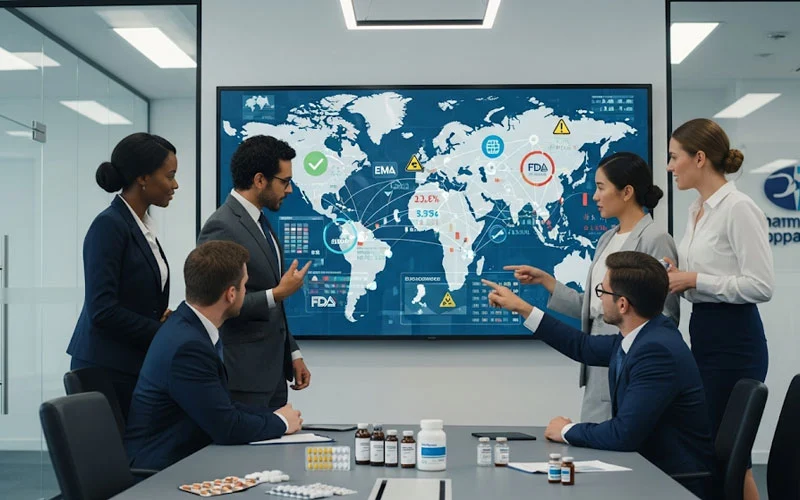The pharmaceutical marketplace has always been an evolving environment. Over the last few years, global buyers have experienced an unprecedented amount of volatility - from abrupt regulatory changes in emerging markets to sudden price policy shifts in price policies in developed economies. For those charged with sourcing medicines, active pharmaceutical ingredients (APIs), or finished formulations, keeping up with the changes is not a choice, it's between getting on the right supply chains and facing surprise hurdles.
In this insight, let’s take a look at what’s changing, why it's important, and what pharma buyers should be looking for as they attempt to chart the changing regulatory landscape.
1. Trade Policies Are Tightening – Especially on APIs
One of the biggest problem in the past decade has been, the world’s reliance on only a few countries to manufacture APIs. Governments are now looking to change that by pushing to diversify supply chains, which is beginning to show in the import / export regulations.
- India has tightened export norms on a few essential medicines.
- The EU is discussing enforceable local sourcing mandates on essential APIs.
- The US has introduced incentives for producers to manufacture domestically, to reduce the dependency wholly.
For buyers this means watching export license requirements, lead times, and potential trade restrictions on products that might be included in previously signed contracts. An attitude of “business-as-usual” can lead to missed communication about export restrictions and possibly rely on the supplier to perform their own due diligence before shipment, only to have your shipment delayed or cost charged on a different price list.
2. Pricing Controls Are Moving Beyond Generics
Traditionally, price ceilings and direct price negotiations with governments occurred mostly with generics. And now we see more broadly:
- China's Group Purchasing Organizations through centralized procurement has driven down costs drastically but put suppliers in a position to compete on extremely low margins.
- Countries in Europe are starting to link reimbursement to "value based pricing" which comes with multiple reviews before they can consider appropriately reimbursing a drug.
- Emerging market countries such as Brazil and South Africa are placing more robust limits on mark-ups to enhance affordability.
For buyers operating in the pharma space, two challenges emerge:
-Negotiations with suppliers need to include localized, government mandated ceilings now.
-Cross border parity means transparency is not voluntary when governments start benchmarking against international prices.
3. Compliance Expectations Are Rapidly Getting Stricter
Global buyers are used to considering cost and availability, but compliance expectations and requirements are also critical. Here are some example trends:
- More and more markets are making serialization & track-and-trace systems mandatory and therefore, noncompliance could impact shipping.
- Environmental and sustainability audits are now features of regulatory reviews, particularly for manufacturing with chemicals.
- Now there are some obligations around data transparency, including the EU Falsified Medicines Directive obligations around clear digital documentation at every touch point.
In practice, this means buyers must check suppliers, and approve them not only for compliance to GMP, but also for readiness with digital traceability tools. Noted, your supplier could lose access to important markets if they don't address these obligations.
4. Currency Fluctuations & Tariffs as Hidden Costs
Even when there are regulations, changes in currency and unforeseen tariffs can dramatically change the landed costs of a product. For example:
- Recent tariff escalations between certain trade blocs have created 5–10% hidden costs on APIs.
- Currency depreciation with almost no time to develop contracts in some emerging markets has made the price front end of contracts harder to pin down.
- Clever buyers have increasingly been using multi-currency clauses and forward contracts to hedge such surprises.
5. What Should Buyers Do Next
Instead of waiting until something changes and reactively address it, buyers can take measures to address regulations more proactively:
- Create a diversified supplier network across several regions and countries to limit dependence on any single country.
- Stay closer to the pulse of regulatory changes by keeping a watch efficiently on government notifications, trade associations, or local distributors.
- Standard Vendor Evaluation should also assess compliance readiness.
- Utilize Supply Chain Management (SCM) type tools that mine large data sets to assist procurement and sourcing to follow day-to-day contracting, real-time pricing, tariff changes and lead-times.
- Negotiate for flexible contracts that allow changes in regulations, costing, or other factors without leaving your firms assets exposed.
Final Thought
Regulatory changes on trade and pricing are not merely updates and bureaucratic formalities. They directly relate to the availability, costing and competitiveness of pharmaceuticals in the broader global marketplace. For current pharma buyers, the future winners will be those who stay current on the changes, expand their ways of sourcing, and have compliance as a major pillar of their future sourcing strategy and not just an aside issue.
In short: if the rules are changing, your sourcing strategy must change too.

